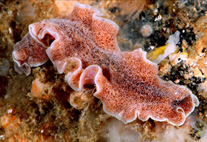Abstract
Polyclads are free-living Platyhelminthes with a simple, dorsoventrally flattened body and a much ramified intestine. In Brazil, 66 species are reported; only three from Rio de Janeiro State (RJ). The main objective of this study is to describe and illustrate coloration pattern, external morphology, reproductive system morphology and, when possible, biological and ecological aspects of species of the suborder Cotylea found in Cabo Frio, RJ. Of the 13 cotylean polyclad species found, Pseudobiceros pardalis, Cycloporus variegatus and Eurylepta aurantiaca are new records from the Brazilian coast and one species is new to science, Pseudoceros juani sp. nov. Feeding observations were made of four species. It is the first time that Lurymare utarum, Cycloporus gabriellae, C. variegatus and E. aurantiaca are illustrated with digital photographs of live specimens and histological preparations. This study increases to 70 the number of Brazilian Polycladida and to 14 the number of species known from Rio de Janeiro State. However, the knowledge about Polycladida in Brazil still has gaps, with great parts of the coast remaining unsampled.

